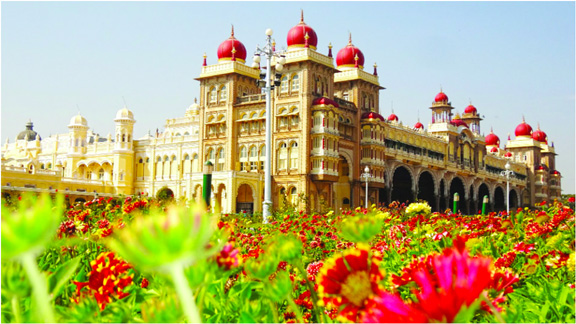
Located at the base of the Chamundi Hills about 150 kms away from Bangalore, Mysore is the second most populous and the second largest city in the state of Karnataka. One of south India’s most famous tourist destinations, Mysore is synonymous to royal past and regal remnants. Glittering royal heritage and magnificent monuments and buildings mark the city’s tourism scene. The most famous dynasty that ruled the city is of the Wodeyars. This is also the place that has seen the rise and revolt of Tipu Sultan. Apart from history, Mysore is also known for the production of premium silk, sandalwood and incense. Not to mention the fact that Mysore is one of India’s best places to practice yoga.
When you are in Mysore you are so close to royalty that you feel like a king of lost land itself. The reason behind this is simple; almost all the major places to visit in Mysore are related to some story of history and glory. In this city, you are never too far away from a heritage building or a mansion with royal connections and lineages. There is a reason why Mysore is called the City of Palaces! The iconic Mysore palace continues to be the face of all the heritage buildings of the city but there are other places also that will take you a step closer to royal living. These places include Jaganmohan Palace, Royal Orchid Metropole, Clock Tower, Gun House, Town Hall, Wellington Lodge, Rajendra Vilas Palace, Karanji Mansion, Jayalakshmi Vilas Mansion, Lalitha Mahal Palace, Crawford Hall, Brindavan Gardens, St.Philomena’s Church, Jayachamarajendra Art Gallery, Shri Chamundi Temple and Srirangapatna.
MYSORE PALACE
Set in the centre of sprawling grounds, Amba Vilas Palace overwhelms at first sight. It was built nearly a century ago and designed by British architect Henry Irwin, who was the Madras state consultant. It stands on the same grounds of the old wooden palace which was burned down by fire. The building is a dramatic three-storied stone edifice built of fine gray granite. It has deep pink marble domes dominated by a five-storied 145 ft tower with a gilded dome topped by a single golden flag. It is built in the classic Indo-Saracenic style with its façade flaunting onion domes, turrets, minarets, cupolas, canopies with arches, intricate balconies, porches and colonnades. On Sundays and public holidays, the exterior of the palace is lighted up with some 97,000 light bulbs, which present an ethereal picture. The interiors are equally lavish—the ceilings are of carved mahogany, while beautiful stained glass windows and glazed tiled floors make for an opulent harmony. The palace also houses a huge collection of art and sculpture from all over the world.
GOLDEN THRONE
Though the palace itself is overwhelming and awe-inspiring, the sight that usually stuns people is the magnificent Durbar Hall, with its ornate ceiling and vividly painted colonnades. Also watch out for the intricately carved wooden doors which lead to more lavish rooms while a massive balcony provides an unhindered view of the parade grounds and of Chamundi Hills beyond. However, even more stunning is the Golden Throne or Ratna Simhasana. It is on display only during special occasions such as Dussehra. It is a magnificent and majestic throne mounted on a platform with steps leading up to the main seat. A beautiful golden umbrella hangs over the seat. The base structure is carved out of fig wood and inlaid with ivory plaques. Covered with gold and encrusted with precious stones, silver and jewellery, the throne looks majestic. It is embellished with the Holy Trinity, female figurines, soldiers, elephants, horses, creepers and other patterns.
RESIDENTIAL MUSEUM
A little lane by the side of the main palace, lined with souvenir shops, leads to the Residential Museum. It is not large but it is filled with paintings from the Thanjavur and Mysore schools, inlaid with precious stones and gold leaf. The museum also houses a collection of royal silver ware, musical instruments, crystal, chandeliers, children’s toys, furniture, royal trousseaux, and such others. But the most fascinating aspect is the armoury with its quaint and fierce looking implements including pistols, guns and other weapons. Many of the 725 weapons and military exhibits in the palace have aesthetic as well as historic value. Some of the weapons belonged to the rulers of Mysore, such as the sword that belonged to Kantirava Narasaraja Wadiyar, who ruled from 1638 to 1659, and those that belonged to Hyder Ali and Tipu Sultan. They also have interesting inscriptions, such as the one found on a gun captured under Wellesley in 1803. Weapons ranging from swords to maces, daggers and their gripped relatives pachakatari, bows, arrows, spears, lances, cannons, and even deadly walking sticks are displayed. Helmets, armour and shields also form part of the collection.
THE FORT
Faced with the grandeur of Amba Vilas Palace, it is easy to miss the historic fort that surrounds it. The original walls were built under the Wadiyars in 1524 but gradually the defensive glacis was flattened and defensive ditch was filled, but the stone wall is still intact. Over time, the wall was rebuilt and extended several times, the mud walls replaced eventually with stone. Later, Tipu had them pulled down with plans to rebuild but died before the plans came to fruition. Subsequently, they were reconstructed by the British in 1799. Originally, the fort area was a bustling centre of life, packed with houses, but these were moved out in 1910. Taking a walk around the fort’s walls will require about one hour during which many landmarks outside the walls and a plethora of temples inside the walls will be visible. If you’re pressed for time, hop into a tonga and go around the fort walls, which is amongst Mysore’s unique experiences.





Be the first to comment